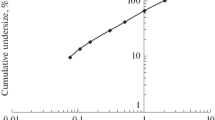Abstract
Bioleaching of a low grade chalcopyrite (ball mill spillage material) was tested for copper recovery in shake flasks. The original samples (as received) were thermally activated (600°C, 30 min) to notice the change in physico-chemical and mineralogical characteristics of the host rock and subsequently its effect on copper recovery. A mixed culture of acidophilic chemolithotrophic bacterial consortium predominantly entailing Acidithiobacillus ferrooxidans strain was used for bioleaching studies and optimization of process parameters of both original and thermally activated samples. Mineralogical characterization studies indicated the presence of chalcopyrite, pyrite in the silicate matrix of the granitic rock. Field emission scanning electron microscopy coupled with Energy dispersive spectroscopy (FESEM-EDS) and X-ray Fluorescence (XRF) analysis indicated mostly SiO2. With pH 2, pulp density 10% w/v, inoculum 10% v/v, temperature 30°C, 150 r·min−1, 49% copper could be recovered in 30 days from the finest particle size (−1 + 0.75 mm) of the original spillage sample. Under similar conditions 95% copper could be recovered from the thermally activated sample with the same size fraction in 10 days. The study revealed that thermal activation leads to volume expansion in the rock with the development of cracks, micro and macro pores on its surface, thereby enabling bacterial solution to penetrate more easily into the body, facilitating enhanced copper dissolution.
Similar content being viewed by others
References
Wang S. Copper leaching from chalcopyrite concentrates. Journal of Microbiology, 2005, 57(7): 48–51
Crundwell F K. The influence of the electronic structure of solid on the anodic dissolution and leaching of semiconductor sulphide minerals. Hydrometallurgy, 1988, 21(2): 155–190
Panda S, Sarangi C K, Pradhan N, Subbaiah T, Sukla L B, Mishra B K, Bhatoa G L, Prasad M S R, Ray S K. Bio-hydrometallurgical processing of low grade chalcopyrite for recovery of copper metal. Korean Journal of Chemical Engineering, 2012, 29(6): 781–785
Panda S, Parhi P K, Pradhan N, Mohapatra U B, Sukla L B, Park K H. Extraction of copper from bacterial leach liquor of a low grade chalcopyrite test heap using LIX 984N-C. Hydrometallurgy, 2012, 121–124: 116–119
Panda S, Sanjay K, Sukla L B, Pradhan N, Subbaiah T, Mishra B K, Prasad M S R, Ray S K. Insights into heap bioleaching of low grade chalcopyrite ores: a pilot scale study. Hydrometallurgy, 2012, 125–126: 157–165
Pradhan N, Nathsarma K C, Rao K S, Sukla L B, Mishra B K. Heap bioleaching of chalcopyrite: a review. Minerals Engineering, 2008, 21(5): 355–365
Acar S, Brierley J A, Wan R Y. Conditions for bioleaching a covellite-bearing ore. Hydrometallurgy, 2005, 77(3-4): 239–246
Watling H R. The bioleaching of sulphide minerals with emphasis on copper sulphides: a review. Hydrometallurgy, 2006, 84(1-2): 81–108
Munoz J A, Dreisinger D B, Cooper W C, Young S K. Silver catalyzed bioleaching of low grade ores. Part I. Shake flasks tests. Hydrometallurgy, 2007, 88(1-4): 3–18
Mishra M, Singh S, Das T, Kar R N, Rao K S, Sukla L B, Mishra B K. Bio-dissolution of copper from Khetri lagoon material by adapted strain of Acidithiobacillus ferrooxidans. Korean Journal of Chemical Engineering, 2008, 25(3): 531–534
Mohapatra S, Sengupta C, Nayak B D, Sukla L B, Mishra B K. Effect of thermal pretreatment on recovery of nickel and cobalt from Sukinda lateritic nickel ore using microorganisms. Korean Journal of Chemical Engineering, 2008, 25(5): 1070–1075
Mohapatra S, Sengupta C, Nayak B D, Sukla L B, Mishra B K. Biological leaching of nickel and cobalt from lateritic nickel ore of sukinda mines. Korean Journal of chemical engineering, 2009, 26(1):108–114
Lennox J E, Blaha T. Leaching of copper ore by Thiobacillus ferrooxidans. American Biology Teacher, 1991, 53(6): 361–368
Xia L, Liu X, Zeng J, Yin C, Gao J, Liu J, Qiu G. Mechanism of enhanced bioleaching efficiency of Acidithiobacillus ferrooxidans after adaptation with chalcopyrite. Hydrometallurgy, 2008, 92(3–4): 95–101
Ahonen L, Tuovinen O H. Microbiological oxidation of ferrous iron at low temperatures. Applied and Environmental Microbiology, 1989, 55(2): 312–316
Modaka J M, Natarajan K A, Mukhopadhyay S. Development of temperature-tolerant strains of Thiobacillus ferrooxidans to improve bioleaching kinetics. Hydrometallurgy, 1996, 42(1): 5l–61
Panigrahi M K, Mookherjee A, Pantulu G V C, Gopalan K. Granitoids around the Malanjkhand copper deposit: types and age relationship. Journal of Earth System Science, 1993, 102(2): 399–413
Marhual N P, Pradhan N, Kar R N, Sukla L B, Mishra B K. Differential bioleaching of copper by mesophilic and moderately thermophilic acidophilic consortium enriched from same copper mine water sample. Bioresource Technology, 2008, 99(17): 8331–8336
Pradhan D, Pal S, Sukla L B, Chaudhury G R, Das T. Bioleaching of low grade copper ore using indigenous microorganisms. Indian Journal of Chemical Technology, 2008, 15: 588–592
Panda S, Panda S K, Nayak B D, Rao D S, Pradhan N, Sukla L B, Mishra B K. Effect of thermal activation on recovery of copper using microorganisms from ball mill spillage. In: Proceedings of the XI International Seminar on Mineral Processing Technology. NML: Jameshedpur, 2010, 955-961
Sohn H Y, Wadsworth M E. Rate Processes of Extractive Metallurgy. New York and London: Plenum Press, 1979
Dreisinger D. Copper leaching from primary sulfides: options for biological and chemical extraction of copper. Hydrometallurgy, 2006, 83(1–4): 10–20
Sukla L B, Das R P. Kinetics of nickel dissolution from roasted laterites. Transactions of the Indian Institute of Metals, 1987, 40(4): 351–353
Mohapatra S, Bohidar S, Pradhan N, Kar R N, Sukla L B. Microbial reduction of nickel from Sukinda chromite overburden by Acidithiobacillus ferrooxidans and Aspergillus strains. Hydrometallurgy, 2007, 85(1): 1–8
Faria de D L A, Lopes F N. Heating goethite and natural hematite. Can Raman spectroscopy be used to differentiate them? Vibrational Spectroscopy, 2007, 45(2): 117–121
Quartz page: Silica group. Available online at http://www.quartzpage.de/gen_mod.html (Accessed February 01, 2012)
Author information
Authors and Affiliations
Corresponding author
Rights and permissions
About this article
Cite this article
Panda, S., Pradhan, N., Mohapatra, U. et al. Bioleaching of copper from pre and post thermally activated low grade chalcopyrite contained ball mill spillage. Front. Environ. Sci. Eng. 7, 281–293 (2013). https://doi.org/10.1007/s11783-013-0484-5
Received:
Accepted:
Published:
Issue Date:
DOI: https://doi.org/10.1007/s11783-013-0484-5




